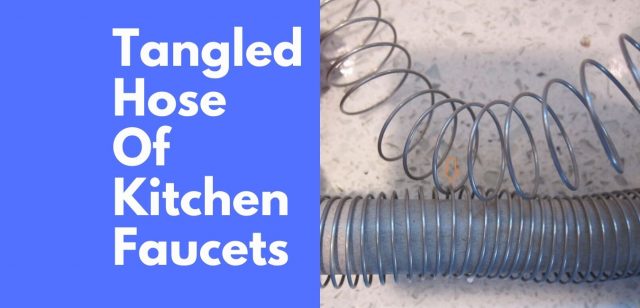Pull-out faucets are immensely gaining popularity nowadays. You will find it installed in almost all modern homes. It is designed with a hose attached to it. It has several benefits and takes convenience to greater heights.
The hose allows for easy maneuverability, which makes your life easy and efficient. It is recommended if you have limited space in your kitchen. However, there are certain downsides to this type of faucet. One of the most common problems that people face is the tangled hose of kitchen faucets.
The hose tends to tangle, which can lead to other issues. This problem may arise from several other factors.

Table of Contents
Common Causes for tangled hose of Kitchen Faucets
A faucet hose can get tangled because of several reasons. By finding out the reasons, you can have a better chance of preventing it from happening again.
High water pressure

The hose of your kitchen faucet can get tangled if the water pressure is too high. It should stay at a moderate level. If not, the water pressure can be too much for the hose to handle. And this might cause the hose to tangle slowly, without your knowledge.
Not only the faucet’s exterior, but extreme water pressure may also ruin its interior parts, which may weaken the entire faucet.
Temperature
Temperature is also one of the leading causes of a tangled hose. Faucets are made of certain metals like brass and stainless steel. Thus, when the hose is continuously exposed to moisture and oxygen, it may weaken and cause the hose to tangle.
The temperature of the water can also play an essential factor. Some households have warm water facilities installed, through which they get warm water from their faucets. If the heated water is allowed to flow from the faucets continuously, the high temperature may erode the hose’s interior. This leads to the tangling of the hose.
It is best to alternate between warm and cold water to avoid tangling the hose. Also, try to keep the temperature of the water under control and make sure it is not too hot.
Worn-out Hose
An old worn-out hose is more likely to get tangled than a new hose. The entire faucet comes with a limited warranty. Of course, the durability of faucets also depends upon the way you use them. However, with extended time and regular use, faucets tend to wear out over time.
Old hoses become soft and brittle, which makes them more susceptible to getting tangled and other problems as well.
Corrosion
Corrosion also increases the risk of your hose getting tangled. As a result of corrosion, both the interiors and exteriors of your faucets may develop a rusty layer. This layer of rust is likely to weaken your entire faucet, including the hose. And the weakening of the hose may lead to tangling.
Cleaning Technique
 Your hose can also get tangled when you are cleaning them. To prevent this from happening, you should always follow the proper cleaning method.
Your hose can also get tangled when you are cleaning them. To prevent this from happening, you should always follow the proper cleaning method.
Using hard detergent and brush can cause tangling of the hose while also allowing rust to occur. When rust sets in, your hose is more susceptible to unwanted tangles.
Problems Associated with Tangled Hose
You may experience various issues if you have a tangled hose. Some of the problems are:
Unwanted Noise
A tangled hose produces a lot of undesirable noise. The sound is produced when water gets blocked by unwanted tangles while rushing through the hose. This noise can be very irritating.
Drop-in Water Pressure:
 One of the most common issues that arise with a tangled hose is a drop in water pressure. The tangled hose prevents the water from flowing freely. This decreases the force of water, which is flowing through the faucet.
One of the most common issues that arise with a tangled hose is a drop in water pressure. The tangled hose prevents the water from flowing freely. This decreases the force of water, which is flowing through the faucet.
This drop in water pressure makes the faucet ineffective and inefficient. Your regular activities become more time-consuming.
Solutions to Fix a Tangled Hose
A tangle in your faucet hose can be very annoying and time-consuming. However, there are several ways through which you can solve this issue.
Removal of Rust
If you notice any rust on your faucet or hose, you may want to remove it. It is best if you remove the rust at the earliest before it worsens your faucet’s performance. For this, you can make a lemon juice paste and salt and apply the mixture to the rusted parts.
Leave it on for about thirty minutes, and brush it off using a soft brush. After this, you need to wash it with clean water and dry it out. You can repeat this process until all the rust is gone.
Duct Tape
The temporary solution to a tangled hose of kitchen faucets is waterproof heavy-duty duct tape. If a particular area tends to tangle every time you pull out your hose, you can secure it with duct tape. However, this method is only a temporary fix.
Call The Plumber
When all else fails, then the best thing you can do is call a plumber. A professional plumber will have all the right tools and skills to fix your tangled faucet hose. You might have to spend some money, but it is still worth it if you want to have a tangle-free faucet.
Replacement
If your tangled hose is beyond repair, then you will have to get a new hose for your faucet. Or, chances are, you may even have to replace the entire faucet.
This is probably the best way to deal with a tangled hose of kitchen faucets. Instead of repeatedly repairing your hose, buying a new one can be the best option for you. You will no longer have to face this problem anymore.
Conclusion
Tangled hose of kitchen Faucets can also be an issue related to poor installation. In this case, you can either tighten or loosen it using a wrench or pliers.
It is not a big challenge to fix a tangled hose. Once you are familiar with the underlying causes and problems, you can take up various measures to fix this issue. But in any case, if you cannot correct it, it is best to let the professionals handle it.
References
https://diy.stackexchange.com/questions/46194/how-to-untangle-spring-for-kitchen-faucet-hose
